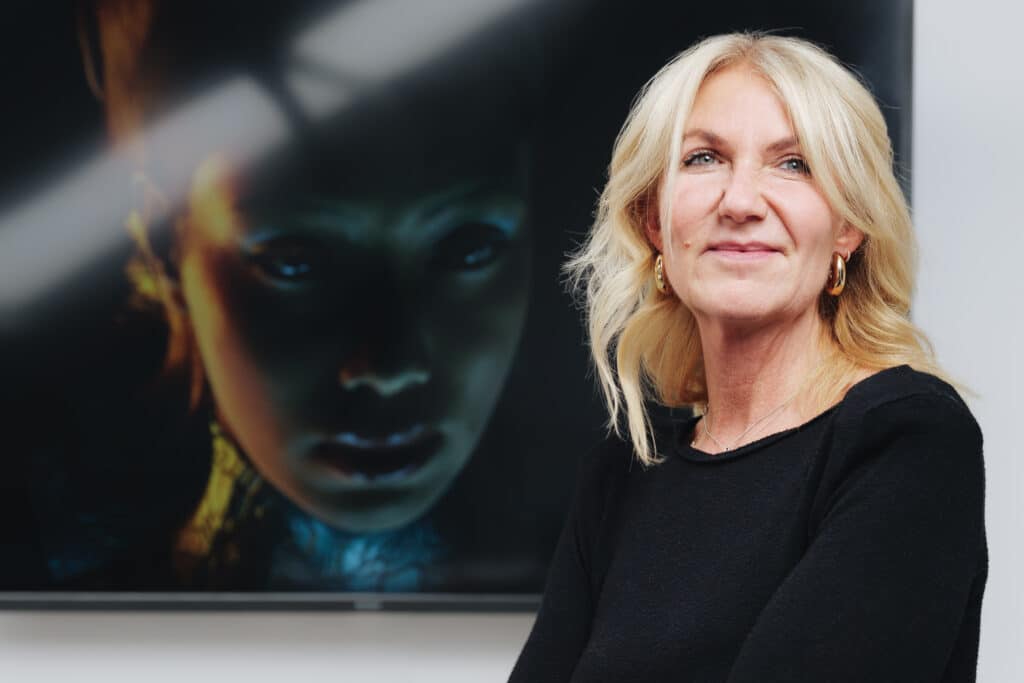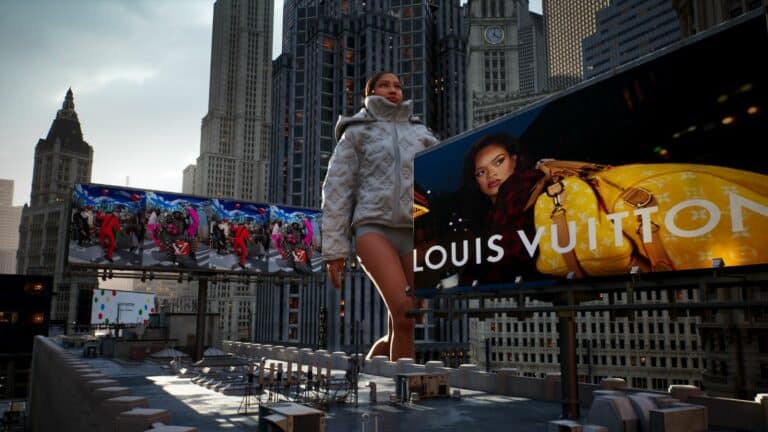Meet Dex. From mixing music in her bedroom to appearing as a DJ at Digital Fashion Week in New York, Paris and London, she’s already made a name for herself at 23-years-old.
She’s anti-fast fashion and thanks to her immersive live performances, now counts Chelcee Grimes and Eurythmics singer Dave Stewart as fans.
But there’s something a bit different about Dex. Unlike your average influencer, Dex is a ‘digital human’, powered by AI and developed by Liverpool-based tech firm Sum Vivas.
Although she initially started out as a digital DJ to complement live events back in 2022, she’s fast become an influencer and is set to release new music after being recognised by industry figures.
You can interact with Dex in the same way as you can with Amazon’s Alexa, and she can even remix a Taylor Swift track. It might all sound very futuristic, but could Dex and a growing army of digital influencers be about to shake up the influencer marketing industry? Denise Harris, co-founder at Sum Vivas and producer and manager of Dex, seems to think so.
“You can achieve the unachievable because it’s digital,” Harris tells Prolific North. “It’s a digital human. It’s never late. It’s never ill. It’s never rude, it will wear what you want to wear. It’ll do what you want it to do. You don’t have to worry about it doing anything not politically correct, digital humans will always stay on brand.”
According to the Influencer Marketing Benchmark Report 2024, the influencer marketing industry is set to grow to around $24bn by the end of 2024 and 63% of respondents said they plan to use AI in executing their influencer campaigns.
That appetite for brands to work with AI-powered digital influencers is growing. BMW recently launched a campaign with ‘Lil Miquela’ for its new electric BMW iX2, and you’ll see virtual girl ‘Imma’ practically everywhere if you pay a visit to Japan.
It’s all part of how a business can show that it’s “visionary” and “forward-thinking”, says Harris.
“The content you can create is going to be cheaper than flying an entire team to a foreign country and getting cinematic production for ad campaigns, because it’s digital.”
The story behind Dex
Dex first emerged after Harris spotted an opportunity in live events, realising audience expectations had “completely changed”.
“People want something immersive and interactive. By creating a digital human DJ, we knew that it would open up opportunities for live events, and to be able to bring a bit more of a wow factor to traditional concerts.”

The initial idea was that Dex would be a hologram, DJing at gigs and live shows alongside other performers and artists. As the producer and manager of Disco Classical, a popular live show with an orchestra band and singers, Harris decided to integrate tech into the events using digital human Dex to tap into a growing, younger audience.
“Dex has started to get attention and bookings herself, which has nothing to do with the concerts that I do. With the DJ sets and her social media platforms, by creating digital human DJ she’s become like a social media influencer in her own right.”
The goal was to give audiences more of an experience at live shows, but soon came the realisation that it’s a “very niche market full of technical challenges”.
Instead of outsourcing the work for Dex, Harris co-founded Sum Vivas so she could build an in-house team to specialise in creating interactive, AI-powered digital humans, environments, clothing and 3D digital assets, for all types of businesses.
But it was only last year that Sum Vivas reached a major step by integrating AI with its digital humans following funding from Innovate UK’s Creative Catalyst 2023 programme, meaning Dex can now interact and communicate in real-time. The Department for Business and Trade also invited Sum Vivas along for a recent UK Northern Powerhouse delegation to Japan.
“We’re now producing these for other people and other businesses,” says Harris, who believes the company’s digital humans are reliable brand ambassadors, and a new tool to bring brand campaigns to life.
But where does this leave human influencers working across the North?
The influencer battle
Four years ago, Sammy Gray and Courtney Reynolds were two final year drama students, studying at Liverpool John Moores University.
Then Covid hit. Unable to attend lectures in person thanks to waves of lockdowns, they started posting short comedy skits on TikTok.
Now known as Grayskitz across social media, they’ve since had over 300 brand collaborations with the likes of NatWest and already racked up an impressive 2.7m followers on TikTok, with a further 1.4m views on YouTube.

“The industry we’re in is forever changing, creating new challenges which we actually see as opportunities,” says the duo. “Content creation is forever evolving and AI will make that change even faster, but we’ve always changed and adapted.”
While some influencers may fear their brand collaborations, followers, and income may be under threat from digital influencers, Gray and Reynolds feel differently.
“Over the four years, our brand collaborations have evolved,” they explain. “In the early days, we would get loads of gifted collaborations and requests for collaborations paid in product sales commissions. However, we now tend to do paid collaborations and gifted collaborations with brands we love.”
Agreeing to around five or six brand collaborations a month out of 10 to 12 requests, the number and value of paid collaborations hasn’t dipped – if anything, they’ve “increased”.
“We are attracting more and more household name brands to our roster. We have very good relationships with a full range of major ad agencies in the UK. Which again, we are very grateful for.
“We don’t have any concerns about how AI will impact our relationships with brands and fans in the future. In fact, quite the opposite.
“For AI, we are very much seeing it as a huge positive where we will be able to improve and enhance our content in ways that still engage our fans. Over one billion views tells us that our audiences across all social platforms continue to like and engage with what we do. We very much see AI as a massive opportunity.”
The quest for sustainability, authenticity and opportunities for the future
Dex recently featured in a campaign, parading through the streets of New York in a Louis Vuitton puffer jacket. There was no need for international flights, hair and makeup teams, and roads didn’t need to be closed down.
“We could do it in Unreal Engine as part of the campaign in our office,” says Harris. “From a sustainability point of view, air miles, landfill on clothing, you’re able to hit the green agenda because it’s digital.”
Aside from sustainability, while authenticity might be a central selling point for a human influencer, they can fall foul of controversy.
“The biggest thing that sets apart an influencer to the public, is if they’re genuine and authentic. So you can have a human that all of a sudden loses all their followers because they’re not being authentic.
“If you’re managing a digital human, there’s a group of professionals who are managing that campaign who will ensure it is authentic, genuine and that the moral value behind it is thought through with a lot more care, and it’s a planned approach.”

This is a “huge subject and critically important,” says Gray and Reynolds. With the industry recently going through a stage where de-influencing gained some publicity, they “deliberately” stepped away from it.
“We always strive to take a backseat when it comes to controversy as our aim as content creators is ultimately to make people laugh through our videos. We pride ourselves in being huge on brand safety and integrity, and know that because we avoid controversy, major brands choose us to work with and feel very safe in doing so.
“In terms of cost and value, time will tell. But we feel at this stage, having a connection with your audience and listening to what they want to see is equally important. Has AI proven to do this yet?”
Scripting their own content for brands, the most important rule to the duo is “remaining authentic” to their own content style, which they say has worked for many of their clients such as NatWest, Tango, Domino’s, SP Energy and ITVX.
Harris agrees: “It’s absolutely the human element behind it. Whether you’re digital or real, it’s the people behind the posts that will be authentic or not authentic.”
Despite some fearing AI will take jobs away from humans, Harris says digital humans have the potential to create even more jobs and opportunities across a wide range of industries.
“It’s a new world. It’s technology that’s moving forward and it’s creating masses of jobs for people who didn’t have jobs,” she says. “I think it’s just progression, creating jobs rather than taking.”
Working with students at the School of Digital Arts (SODA) at Manchester Met University, Sum Vivas is showcasing how the skills that go into developing Dex and other digital humans can be used in the workplace.
“If I think about the roles that can work within an AI influencer, you have people working in motion capture, videographers, people working in Unreal Engine, music, design, and digital fashion. The more businesses using AI influencers, the more jobs it’s creating.”
As for the future, AI might not just be powering digital humans, but the content we see from human influencers on social media too.
“We are currently at the very early stages of working with an organisation who say they can enhance our content using AI,” says Gray and Reynolds.
“For us we will be keeping all options open including AI. It’s about taking the opportunity and moving with the times.”
The duo believe there will be “room for both real authentic content creators and AI influencers” as the use of each will “very much still be brand and product specific”.
“But again, time will tell if this will be a phase or something more permanent.”










